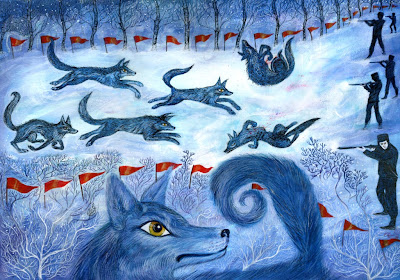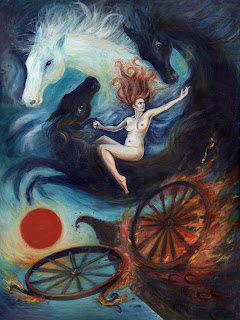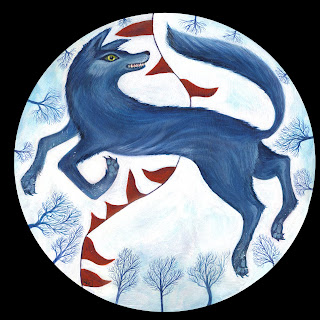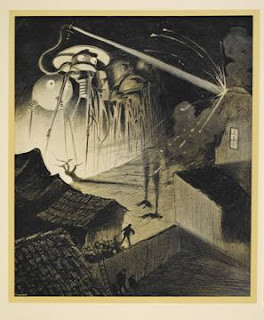Out of this World: Science Fiction but not as you know it is the British Library’s first exhibition to explore science fiction through literature, film, illustration and sound and opens next month, running until September. The Library tells us "it will challenge visitors’ perceptions of the genre by uncovering gems of the Library’s collections from the earliest science fiction manuscripts to the latest best-selling novels."
Guest-curated by
Andy Sawyer, Science Fiction Collections Librarian at the University of Liverpool, the exhibition will trace the development of the genre from
True History by Lucian of Samosata written in the 2nd century AD to the recent writings of Cory Doctorow and China Miéville, showing how science fiction has turned from a niche into a global phenomenon.
Events include appearances by several British comic creators including
Alan Moore and
Neil Gaiman.
Here's a full list of all events.
 Out of this world: Why Science Fiction speaks to us all
Out of this world: Why Science Fiction speaks to us allFriday 20 May 18.30 - 20.00
Throughout history, people have asked ‘what if?’ We have always allowed our imaginations to create other worlds as expressions of our wildest dreams, hopes and fears, and so better to understand our own. ‘Science Fiction’ expresses this human need in potent ways, but so does the work of Swift, Lewis Carroll and George Orwell. The story and present state of our speculations are explored by China Miéville (right), Adam Roberts, Tricia Sullivan and special guests. £7.50 / £5
Out of this World: Science and The FutureA short series of discussions exploring the cutting edge thinking and scientific research and ideas that may determine the kind of future we will have on earth. This is the thinking that may seem like science fiction but will be revolutionary in our lifetimes; although it is not without controversy. Leading scientists, theorists and writers share their thoughts.
Who owns the story of the Future?Tuesday 24 May 18.30 – 20.00
Will the future be better or worse? – and does the story we are telling ourselves help or hinder us? Can we make the right choices, and deal with the grand challenges ahead or will our ambitions and lack of political will get in the way. Jon Turney (
The Rough Guide to The Future) chairs a panel including economist Diane Coyle (
The Economics of Enough), technology and SF writer Cory Doctorow and Mark Stevenson (
An Optimists Tour of the Future). £7.50 / £5 Concessions
Compared to this, the Industrial Revolution was nothing!Wednesday 25 May 18.30 - 20.00
Is the ‘ultimate reboot’ is coming as the Genetics, Nanotechnology and Robotics/AI revolutions intertwine and pick up speed? Are we heading toward a radically different society where our notions of old age, scarcity and our institutions have to be radically rethought? Or have we heard it all before? Speakers include Richard Jones (University of Sheffield, author of
Soft Machines; Nanotechnology and Life) Robin Lovell-Badge (Head of Stem Cell Biology and Developmental Genetics at the National Institute for Medical Research) and Anders Sandberg (Future of Humanity Institute). Chair, Jon Turney. £7.50 / £5 Concessions
Fixing the Planet: have we finally got some concrete options?Friday 27 May 18.30 - 20.00
From carbon scrubbing, to fourth generation bio-fuels, to biochar, to improved grassland management – we have the tools to deal with the climate change crisis in short order. So why don’t more of us know about them – and what can we do to start putting them into action? Speakers include Chris Goodall (Ten Technologies to Save the Planet), Tim Kruger (Oxford Geoengineering Research) and Mark Stevenson. £7.50 / £5 Concessions
The Beginning of Infinity: Explanations that transform the WorldTuesday 31 May 18.30 – 20.00
David Deutsch, the acclaimed physicist and author of
The Fabric of Reality, explores the big issues that inform our understanding of how the physical world works. His much awaited new book, The Beginning of Infinity reaches some startling conclusions about the nature of human choice, scientific explanation and the evolution of culture. Chaired by Graham Lawton, Deputy Editor,
New Scientist. £7.50 / £5 Concessions
The Age Of Entanglement: are we too intertwined with technology?Friday 3 June 18.30 – 20.00
“As technology infiltrates every aspect of our lives it’s become a life support system without which we can’t survive” (James Burke). Are we too dependent on our technologies, or are they the key to a bright future? Are we subjugated or emancipated by them? Speakers include technology writer and broadcaster Aleks Krotoski and Sherry Turkle (Massachusetts Institute of Technology, author of
Alone Together). £7.50 / £5 Concessions
Airborne Dreaming; a prehistory of flightFriday 3 June 13.00 – 14.30
Flight is one of the defining dreams of magic, myths and fairy tales. In
The Arabian Nights above all, early scientific fantasies of flight, imaginary voyages and utopias give us the flying carpet, a vehicle of rapture and ecstasy as well as power over time and space. Prize-winning writer of fiction, criticism and history, Marina Warner, explores these magical and prophetic annunciations of the coming era of powered flight. £6 / £4 concessions
Utopias and Other WorldsMonday 6 June 18.30 – 20.00
The Culture, a vast anarchic and utopian interstellar society, is one of the most extraordinary settings in modern literature, and it follows a long tradition of imagined worlds, perfect or otherwise. Its creator, acclaimed novelist Iain M Banks, is joined by Gregory Claeys, author of
Searching for Utopia, to trace the long history of the idea, and Francis Spufford, whose Red Plenty explores the world of Soviet idealism. £7.50 / £5 Concessions
H G Wells: The Man Who Invented TomorrowWednesday 8 June 18.30 - 20.00
‘Scientific romances’ such as
The Time Machine and
The War of the Worlds, within a prolific career as writer and social thinker made H G Wells the most famous author in the world. Yet his life and ideas were full of contradiction. Wells is the subject of
A Man Of Parts, the new novel by David Lodge, who discusses this complex and intriguing figure with Stephen Baxter, whose
The Time Ships was an authorised sequel to Wells, and Adam Roberts, SF writer and Professor of Nineteenth-Century Literature at Royal Holloway, University of London. £7.50 / £5 concessions
The Art and Science of Time TravelFriday 10 June 18.30 – 20.00
From Madeline D'Engle's
A Wrinkle In Time to
Doctor Who and Kurt Vonnegut’s
Slaughterhouse 5 the concept, appeal and paradoxes of time travel have inspired many mind-boggling flights of the imagination. Join the creators of two superb recent experiments with the idea: Stephen Baxter, whose
The Time Ships is a sequel to HG Wells, and Audrey Niffenegger, the author of the best selling
The Time Traveler’s Wife. Acclaimed science writer John Gribbin will be the evening’s authority on the theory and logic of time travel. £7.50 / £5 concessions
SPECIAL EVENT: LATE AT THE LIBRARY- OUT OF THIS WORLD Global Communication and The Radio Science Orchestra live with DJs Rob da Bank and Jon HopkinsFriday 17 June 19.30 – 23.00
Join the Library as they go into interstellar overdrive at a unique music event to celebrate ‘Out Of This World’. A rare chance to catch the theremin led retro-space sound of Bruce Woolley’s Radio Science Orchestra featuring Ken Hollings, in
Return To Mars. They are followed by the return of Global Communication, one of the pre-eminent electronic acts of the modern era, performing live for the first time in 15 years. Plus the exceptional DJs Rob da Bank and Jon Hopkins and a special appearance by the Immaculate Extremists. Please dress futuristically! And come to our Illamasqua sci-fi salon on the night for a fabulous makeover. £12.50
Space Children: From Dr.Funkenstein to the ArchAndroidSaturday 18 June 15.30 – 17.00 (plus film screening at 14.00)
The afrofuturistic imagination reached fantastical heights in the lavish science fiction inspired stage shows, costumes and concept albums of US funk acts Parliament and Labelle. George Clinton, whose P-funk mythology turned his whole band into characters from a wild space opera comes to the British Library to talk about all things galactic in his career. He shares the event with Nona Hendryx from Labelle, whose concerts and extraordinary styling in the mid 1970s had to be seen to be believed. A multimedia journey into this thrilling world, that also features special film of their heiress Janelle Monae, 'the ArchAndroid'.The event will be preceded by a rare screening of John Akomfrah’s documentary
The Last Angel of History at 14.00. £7.50 / £5 concessions
Brian Aldiss, John Clute, Michael Moorcock and Norman SpinradTuesday 21 June 18.30 - 20.00
A rare chance to spend an evening with four of the most extraordinary writers of modern times: Brian Aldiss, John Clute, Michael Moorcock and Norman Spinrad. Each has had a long, diverse writing career encompassing novels, short stories, essays and non fiction; championing originality and freely blending the literary mainstream with fantasy, science fiction and absurdism. Moderated by Roz Kaveney. £7.50 / £5
Mary Shelley and Romantic Science (and that Creature)Wednesday 22 June 18.30 - 20.00
Mary Shelley was still Mary Godwin, and only 18 years old, when she began the short horror story that eventually became one of the most influential novels of the 19th century:
Frankenstein, or the Modern Prometheus. Acclaimed biographer and historian of science Richard Holmes depicts an era of scientific speculation that enabled Mary to conceive her extraordinary Creature, and his visionary creator, Victor Frankenstein. £6 / £4 concessions
Aliens and The ImaginationTuesday 28 June 18.30 - 20.00
Are we alone in the universe? While we wait for an answer that may never come, we seem compelled in the meantime to imagine alien encounters, devise extraordinary alien worlds and races and find ‘the other’ much closer to home. Fascinating presentations and discussion from film director Gareth Edwards (
Monsters) author Gwyneth Jones, Mark Pilkington (
Strange Attractor); scientists and writers Jack Cohen and Ian Stewart, (
What Does a Martian Look Like?: The Science of Extraterrestrial Life) and David Clarke, Sheffield Hallam University and consultant to the National Archives UFO project. Chaired by Bryan Appleyard. £7.50 / £5 concessions
Niall Ferguson: Civilisation and Virtual HistoryWednesday 29 June 18.30 – 20.00
What if the Spanish Armada had been victorious? What if Germany had won the Second World War as imagined in Philip K Dick’s
The Man In The High Castle? Imaginative writers have often used ‘counterfactualism’ as a device but rarely historians. Niall Ferguson, writer of many acclaimed books and presenter of Civilisation The West and the Rest, outlines some of the intriguing scenarios that could have resulted in a completely different world to the one we know, and explores how this speculation helps us understand history. £7.50 / £5 concessions
The Universes of Alan MooreMonday 4 July 18.30 - 20.00
Alan Moore’s vast forthcoming novel
Jerusalem is set in a four dimensional world of overlapping history, personal life and local geography, working class angels and demons. It builds on a remarkable body of work, including
The League of Extraordinary Gentlemen and
V for Vendetta which have made him one of the most influential writers in the history of comic novels. He joins comedian and writer Stewart Lee to discuss many aspects of the real and unreal, time and space, people and places. £7.50 / £5 concessions
Rossum’s Universal Robots (R.U.R) by Karel ČapekWednesday 6 July 18.30-21.15 and repeated on Friday 8 July 18.30-20.00
Ninety years ago the great Czech playwright and novelist Karel Čapek first presented his remarkable play
R.U.R, from which the word 'robot' is derived and which describes the elimination of humanity by robots. A powerful comment on politics and technological progress, it also presages the questions of cloning and nanotechnology of our own time. A staged reading, abridged and directed by Ivor Benjamin. The performance on Wednesday 6 July is followed by a discussion with leading scientists and technologists on the impact of robotics on our lives, past, present and future. £7.50 / £5 concessions
Out of this World classics: selected and dissectedTuesday 12 July 18.30 - 20.00
The organisers of the Arthur C Clarke Award, the leading British SF honour, invite you to join their crack team of panellists as they chose and discuss personal favourites from the British Library's Out of this World exhibition - which takes in everyone from Voltaire to Vonnegut, Thomas More to Alan Moore, and Borges to Burgess. Participants include Pat Cadigan and Paul McAuley. £7.50 / £5 Concessions
Afro Futures: Pumzi plus Q+A with Wanuri KahiuTuesday 19 July 18.30 - 20.00
This stunning short film by Kenyan director Wanuri Kahiu attracted admirers from all over the world when it premièred at the Sundance festival. Set in a dystopian future after water wars have torn the world apart it is a beautifully crafted film, with special effects provided in part by the team behind futuristic shocker District 9. £6 / £4 concessions
Robin Ince's School for Gifted Children Summer Science Fiction ModuleWednesday 20 July 18.30 – 20.30
Robin Ince, presenter on Radio 4's
Infinite Monkey Cage and creator of live shows
Nine Lessons and
Carols for Godless People and Uncaged Monkeys with Brian Cox, presents an evening of comedy, inspired ideas and mini SF lectures from Toby Hadoke, Richard Sandling, Helen Arney and other special guests. £7.50 / £5 concessions
Class, Control and ClonesMonday 1 August 18.30 – 20.00
Science Fiction and Social Science both explore dangerous and difficult ideas about the social world around us, about relationships, and about our reactions to change. One creates imaginative worlds, the other uses observation and evidence. What do ‘social science fiction’ works such as
Brave New World and
The Handmaid’s Tale say about our preoccupations with gender relations, fertility and class? Is it simply a question of science, sex and stereotypes, or do more fundamental ethical, sociological and political issues underpin the fictional worlds created? £6 / £4 concessions
Lemistry – 100 years of Stanislaw LemFriday 9 September 18.30 – 20.00
A truly great European writer, Stanislaw Lem (1911-2006) transcends both Polish literature and his chosen genre, science fiction. Best known for his twice-filmed novel
Solaris, he was a virtuoso storyteller who packed his writing with philosophy, comedy, and allegory. This evenings rich centenary celebration features contributions by writers John Gray, Toby Litt and Wojciech Orliński, and film makers Ari Folman (currently filming Lem’s
The Futurological Congress as follow up to
Waltz with Bashir) and The Brothers Quay. Chaired by journalist and critic Rosie Goldsmith.
Presented in association with the Polish Cultural Institute. £7.50 / £5 concessions
Plus more ‘Out of this World’ events in September to be announced.
The Library's exciting season of events continues in the final weeks of the Out Of This World exhibition. In September, the British Library welcomes best selling author Neil Gaiman, alongside other greats of science fiction and beyond. Further events will be devoted to the exceptional writers J G Ballard, Robert Holdstock and others.
• Out of this World: Science Fiction but not as you know it runs from 20 May – 25 September 2011. Tickets for all events are available at http://boxoffice.bl.uk, by calling 01937 546546 (9am-5pm Mon-Fri) or in person at The British Library.
• Please visit the website for latest news:
www.bl.uk/sciencefiction








































